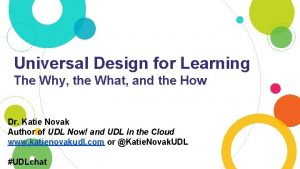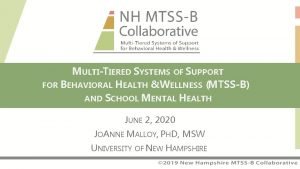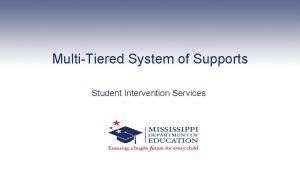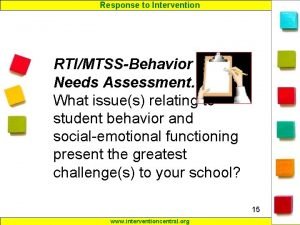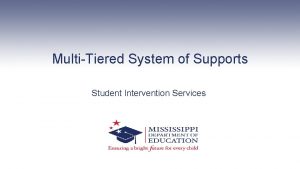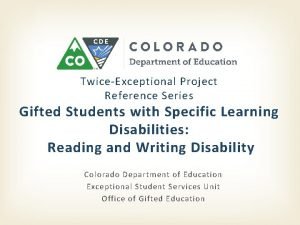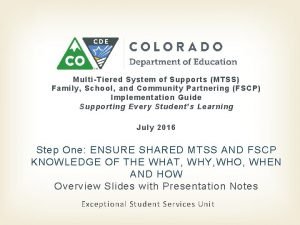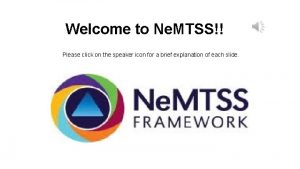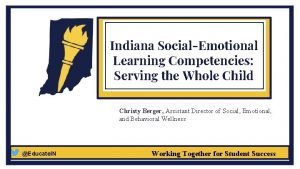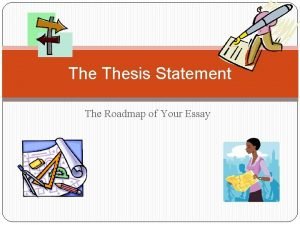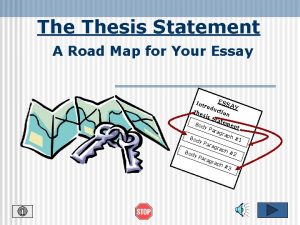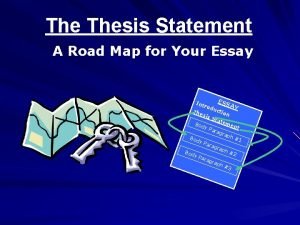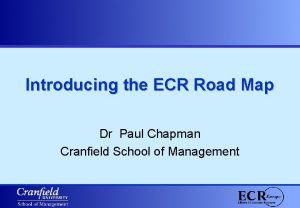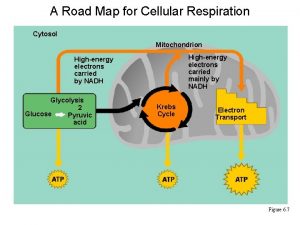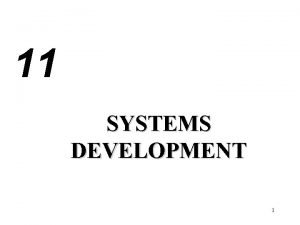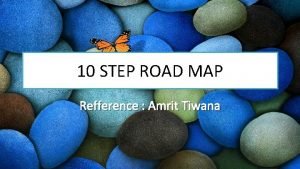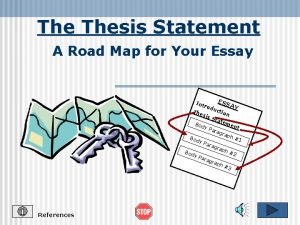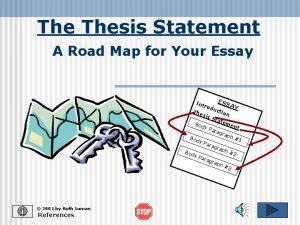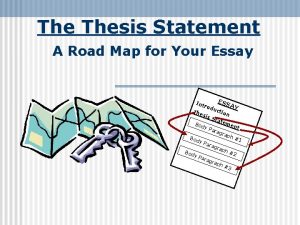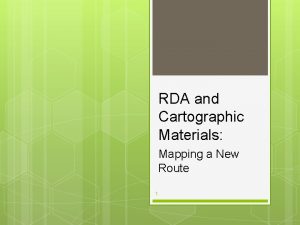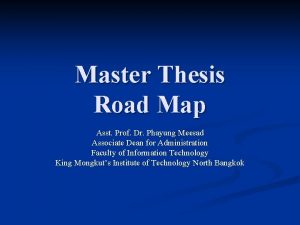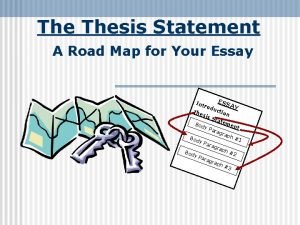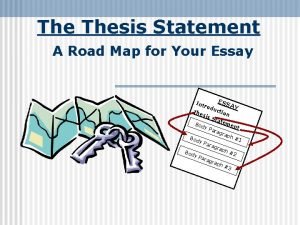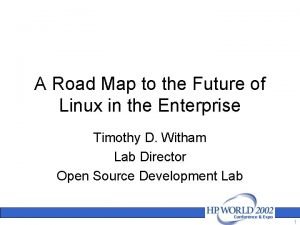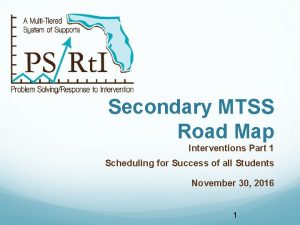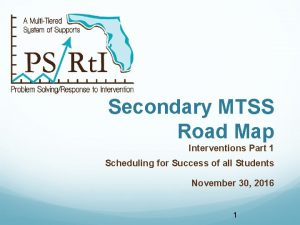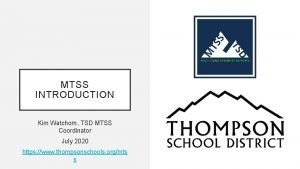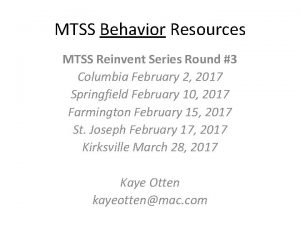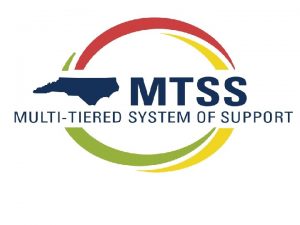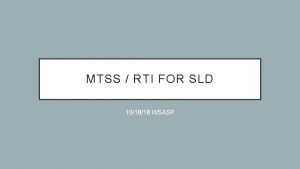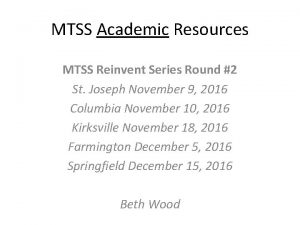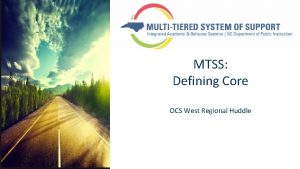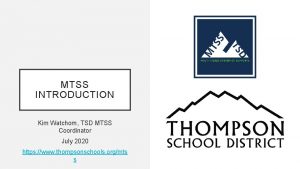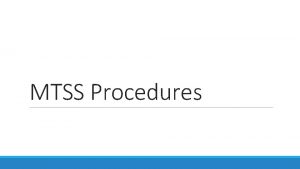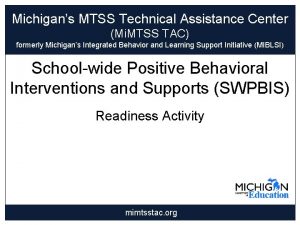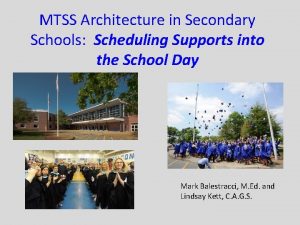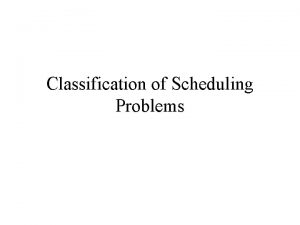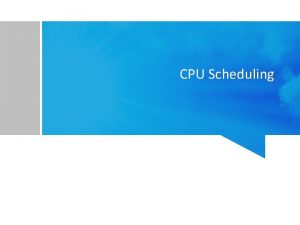Secondary MTSS Road Map Interventions Part 1 Scheduling






































- Slides: 38

Secondary MTSS Road Map Interventions Part 1 Scheduling for Success of all Students November 30, 2016 1

Welcome! Amber Brundage, Ph. D PK-12 Alignment Unit Coordinator FL PS/Rt. I Project Lisa Yount, MS, CCC-SLP Regional Coordinator FL PS/Rt. I Project Ann Selland, Ed. S Regional Coordinator FL PS/Rt. I Project Deanne Cowley, Ed. S Regional Coordinator FL PS/Rt. I Project

Featured Exemplar Presenter Mark Balestracci, M. Ed Principal, Mashpee Middle/High School 3

Adobe Connect Orientation • Intro to Adobe Connect (docs, materials, features, how to participate) • Norms – – How to ask questions – How to participate – Mute speakers – Not rely on raising hands given the size of the group. “Because of the number of participants, we will not use this feature today – but we will have you all type in the chat box, etc. . ” 4

Secondary MTSS Series Needs Analysis • PS/Rt. I Spring Needs Assessments from 2015 & 2016 • Day 1 Secondary Learning Series Evaluations (2016) • State Graduation Rate • Subgroup Gaps • Observation & Self Report Professional Learning Goal • Build capacity of districts to educate secondary students such that instruction is matched to need which results in college and career ready ontime graduates Professional Learning Objectives • Increase knowledge related to characteristics and logistics of MTSS implementation at the secondary level • Demonstrate data-based problem-solving skills to improve secondary level student outcomes such as college and career ready on-time graduates • Using a variety of data sources, practice designing action plans focusing on the consensus, infrastructure, and implementation components necessary to facilitate sustainable MTSS at the secondary level 5

Today’s Agenda • Introductions & Adobe Connect Orientation • Scheduling for the Success of All Students • Exemplar Presenter

#Secondary. MTSS Florida’s Problem-Solving/Response to Intervention Project – – http: //www. floridarti. usf. edu/ Email: rti@usf. edu Facebook: flpsrti Twitter: @flpsrti Florida Positive Behavioral Interventions & Support Project – – http: //flpbs. fmhi. usf. edu/ Email: flpbs@fmhi. usf. edu Facebook: flpbis Twitter: @flpbis 7

SCHEDULING FOR THE SUCCESS OF ALL STUDENTS 8

Learner Outcomes: After today’s session, participants will be able to… 1. Use examples to identify and discuss best practice approaches to illustrate supplemental and intensive intervention and implementation at the secondary level. 2. Identify the organizational structures necessary to develop secondary implementation and sustainability of tiered supports. 9

Bottom Line: only way the needle moves, is through an integrated, schoolwide approach in which everyone owns part of the problem and believes big changes in The achievement can happen. Center on Instruction August 2010 10

Where do we begin? With the structure… Who and what is impacted by the master schedule? or Transp tation lors e s n u Co Support Staff nts Prov Inter vent ing Plann iders ions Courses tors Administra Stude Decisi on Ma Problem So king lving Teachers Recover y Options Parents Data Collec tion Graduation 11

Master Schedule For many schools, the master schedule remains the same from year to year. Why? • It works for the majority of students • The majority of teachers are happy with it, it’s convenient for teachers • It accommodates the bus schedule • It fits in all the lunches • Band, chorus and athletics are accommodated Selecting and Scheduling Interventions in Middle and High Schools 2011 12

Difference between Traditional and Flexible Master Schedules Traditional Flexible Time Bound Flexible and Fluid based on student need Based on a quarter, semester, or school year Offers a variety of intervention courses based on student needs offer more in 9 th and 10 th grade and then taper them off as they need them less in 11 th and 12 th grade. Rigid Base schedule on student need using data: students in most need get scheduled first Difficult to change Changes as students move within interventions Deadlines for changing classes i. e. ; drop add time Ability to change classes as student need changes Based on adult wants and needs Based on students needs Selecting and Scheduling Interventions in Middle and High Schools 2011 13

Scheduling that Supports Student Needs General Curriculum Access • Multi-tiered supports based on student need • Flexible/fluid Student Progression and Graduation Requirements met Credit Recovery Availability • As soon as course failure occurs

How is intensive intervention different from supplemental interventions? Very small groups/and/or individual students What some students receive Focused on skills that pose a barrier to the acceleration of learning Can be targeted to specific skills to enrich A “standard protocol” approach may be utilized • Aligned with core instruction • Provided in addition to core instruction • Decisions are data based only Most intensive instruction available to overcome significant barriers to learning Most narrow focus of instruction/intervention Require effective collaboration and coordination among staff Supplemental Intervention Adopted from Lou Danielson Intensive 15 Intervention

“How the master schedule is constructed may be as important as what the master schedule contains. While the master schedule reveals what is really important to the school, how the master schedule is constructed reveals how professionals interact and how key decisions are made in the school. ” National Association of Secondary School Principals, add year. 16

We are all pretty sure what is best, but how do we make it happen? Best Practices Student need should drive instructional decisions and the amount of support(s) provided Instructional time should be maximized and increased as necessary (e. g. , supplemental instruction). Are we truly using our instructional time to the optimize student learning? Options for intensive classes should offer more variety than just standard intensive classes such as reading, math, science 17

EXAMPLE ONLY Best Practice In Action…. What does that look like? EXAMPLE ONLY Decision rules are established to determine when students will need and no longer need intensive programs If FSA Level 1, and STAR LEXILE below ___ , and i. Ready below____ then REWARDS for phonological issue then Read 180 for comprehenison or If FSA Level 2, and STAR LEXILE below ___ , and i. Ready below____ then Socratic Questioning/Great Books Establishing decision points for students who may need or no longer need intensive interventions is important and should be based on data and transparent to both teachers and students Student scoring _____ on Star Reading Assessment or passing the ACT or FSA will be moved to a CARPD intensive science course before Biology. Student scoring ____on Star Reading Assessment and not passing ACT or FSA will be moved to Intensive Reading II using Great Books 18

How do you develop a master schedule that is aligned to student need? 1. Establish the team • Establish scheduling team or committee (SBLT includes those who are involved in scheduling) • Establish team’s beliefs about student learning 2. Determine all staff who are available to provide additional support 3. Review student data 4. Create the schedule 19

How do you develop a master schedule that is aligned to student need? 1. Establish the team 2. Determine all staff who are available to provide additional support • Assess Staff capacity and availability • Assess teachers’ highly-qualified status and certifications 3. Review student data 4. Create the schedule 20

How do you develop a master schedule that is aligned to student need? 1. Establish the team 2. Determine all staff who are available to provide additional support 3. Review student data • • • Review existing data to anticipate the number of students in need, and what the needs are, for supplemental/Tier 2 intervention* and intensive/Tier 3 intervention* Review intervention maps with current student needed Review course credit codes 4. Create the schedule 21

How do you develop a master schedule that is aligned to student need? 1. Establish the team 2. Determine all staff who are available to provide additional support 3. Review student data 4. Create the schedule • Determine what interventions will be delivered? • Decide when will they be delivered? • Who will provide the interventions? • What will process be when students’ needs change? 22

Recommended Design Criteria for a Master Schedule Template Offer a variety of intervention courses based on student needs. • Fade supports as students no longer need them Design intervention programs to address both academic and engagement deficits Every faculty member has at least two common planning periods per week • Departmental • Grade-level Streamline courses that are more relevant to the school’s population Selecting and Scheduling Interventions in Middle and High Schools 2011

Credit Generating Prevention/Intervention Classes Intensive Reading Intensive Math Intensive Science Ø Can be taken multiple times, earning credit 9 th grade intensive reading should not look like 10 grade intensive reading Ø 24

Scheduling that Supports Student Needs Academies Team teaching Instructional specialists ØTo deliver instruction to students ØTo support classroom teachers Delaware DOE 25

Scheduling that Supports Student Needs, cont. Modify the schedule A Day, B Day Staggered school day Split blocks Common planning time Add minutes to the day Incorporate homeroom into 1 st period Shorten each period to create a ‘skinny’ Extend the lunch period to allow for intervention/enrichment 26

Scheduling the Intervention /Enrichment (I/E) Period There are many options for scheduling the I/E Period including: • • • 1 st period Before late lunch After early lunch At the end of the day All grade levels simultaneously Different grade levels at different times Each option contains both pros and cons! Selecting and Scheduling Interventions in Middle and High Schools 2011 27

The 7 Period Schedule with an Intervention/Enrichment Period Pasco County Example Intervention/Enrichment Period 30 -45 Min. Period 1 Period 2 Period 3 Period 4 Period 5 Period 6 Period 7 28

High School Example - Pasco County- Double Block

High School Example- Anchor Hour Eau Gallie high school

Modified A/B Block Schedule Day M T W TH F M A B A B 1 2 1 2 2 3 4 3 4 Period 5 5 5 5 Block 1 Period Block

THE 8 A/B or 4 X 4 Schedule with 9 th Period Intervention/Enrichment Block High School Example – Pinellas County Day 1 Day 2 0 Period Intervention/Enrichment Block I 1 st period 2 nd period Block II 3 rd Period 4 th period Block III 7 th period 6 th period Block IV 9 th period 8 th period 32

Pompano Beach 4 X 4 4 x 1 Monday to Friday 7: 40 a. m. to Monday to Thursday 7: 15 a. m. Optional Day (Friday) 7: 50 a. m. 2: 40 p. m. to 3: 25 p. m. Home room 7: 40 a. m. -8: 10 a. m. Block 1, academic 8: 10 a. m. 9: 40 a. m. Block 1 7: 15 a. m. -9: 00 a. m. Block 1 7: 50 a. m. -11: 55 a. m. Block 2, elective 9: 50 a. m. 11: 20 a. m. Block 2 9: 05 a. m. -11: 00 a. m. Lunch 12: 00 p. m. -12: 30 p. m. Block 3, academic 11: 30 a. m. 1: 00 p. m. Block 3 11: 05 p. m. -1: 30 p. m. Block 2 12: 35 p. m. -3: 25 p. m. Block 4, elective 1: 10 p. m. 2: 40 p. m. Block 4 1: 35 p. m. -3: 25 p. m. 10 -minute breaks during morning and afternoon sessions Tutoring 2: 45 p. m. -3: 45 p. m. Extracurricular Activities 4: 00 p. m. -5: 00 p. m. 33 © 2015 Hanover Research

Planning for Next Year ta a d g at Wh e goin w are use? to Wh a doe t cour s ou ses sup r data por t When do we start Wh o our does con team sist of D stu ata on den t ne ed What are our priorities 34

Mark’s Presentation Slides 35

Bottom Line: only way the needle moves, is through an integrated, schoolwide approach in which everyone owns part of the problem and believes big changes in The achievement can happen. 36

Questions • Questions/Clarifications

Contact Information • Ann Selland: aselland@usf. edu • Lisa Yount: emyount@usf. edu • Deanne Cowley: dcowley@usf. edu Florida’s Problem Solving/ Response to Intervention Project A Multi-Tiered System of Supports http: //floridarti. usf. edu/ 38
 Job scheduling vs process scheduling
Job scheduling vs process scheduling Mtss and udl
Mtss and udl Christy berger
Christy berger Mtss-b
Mtss-b Symphonylearning com
Symphonylearning com Mtss needs assessment
Mtss needs assessment Mtss documentation packet
Mtss documentation packet Benefits of mtss
Benefits of mtss Mtss
Mtss Mtss nebraska
Mtss nebraska Decreto 283/996
Decreto 283/996 Mtss infographic
Mtss infographic Indiana sel competencies
Indiana sel competencies Paved road vs unpaved road
Paved road vs unpaved road What three things can reduce traction
What three things can reduce traction Road to emmaus map
Road to emmaus map Thesis sentence
Thesis sentence Thesis statement
Thesis statement Thesis/claim and road map
Thesis/claim and road map Mole roadmap
Mole roadmap Reading road map
Reading road map Ecr road map
Ecr road map Which phrase correctly describes the tang dynasty
Which phrase correctly describes the tang dynasty Road map for cellular respiration
Road map for cellular respiration A road map indicating the direction of systems development
A road map indicating the direction of systems development 10-step knowledge management roadmap
10-step knowledge management roadmap Thesis development and road map
Thesis development and road map Thesis statement road map
Thesis statement road map Essay road map
Essay road map Silk road mind map
Silk road mind map Rda maps
Rda maps Thesis road map
Thesis road map Sql road map
Sql road map Krishnanagar karimpur road under bharatmala project
Krishnanagar karimpur road under bharatmala project Thesis development and road map
Thesis development and road map Road map thesis statement
Road map thesis statement Silk road map activity
Silk road map activity Linux road map
Linux road map Road map bdm
Road map bdm

